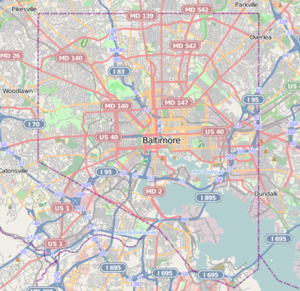Lightship Chesapeake
 |
|
| History | |
|---|---|
|
|
|
| Owner: |
|
| Builder: | Charleston Drydock & Machine Co., Charleston, South Carolina |
| Cost: | $274,434 |
| Laid down: | 6 February 1929 |
| Launched: | 22 October 1930 |
| Acquired: | 23 June 1930 |
| Commissioned: | 1930 |
| Decommissioned: | 6 January 1971 |
| Reclassified: |
|
| Status: | Museum ship |
| General characteristics | |
| Type: | Lightship |
| Displacement: | 130 long tons (132 t) |
| Length: | 133 ft 3 in (40.61 m) |
| Beam: | 30 ft (9.1 m) |
| Draft: | 13 ft 9 in (4.19 m) |
| Propulsion: | Diesel-electric, 350 hp (261 kW) |
| Speed: | 9 knots (17 km/h; 10 mph) |
| Complement: | 10 seamen, 5 officers, 1 cook |
| Armament: | 2 × 20 mm rapid fire machine guns (World War II only) |
|
Chesapeake (lightship)
|
|
| Location | Inner Harbor, Baltimore, Maryland |
| Coordinates | 39°17′8.5″N 76°36′31.6″W / 39.285694°N 76.608778°WCoordinates: 39°17′8.5″N 76°36′31.6″W / 39.285694°N 76.608778°W |
| Area | 0.1 acres (0.040 ha) |
| Built | 1930 |
| Architect | Green, Lewis, II; Charleston Drydock & Machine Co. |
| NRHP reference # | 80000349 |
| Significant dates | |
| Added to NRHP | 1 August 1980 |
| Designated NHL | 20 December 1989 |
United States lightship Chesapeake (LV-116/WAL-538/WLV-538) is a museum ship owned by the National Park Service and on a 25-year loan to Baltimore City, and is operated by Historic Ships in Baltimore, Maryland. A National Historic Landmark, she is one of a small number of preserved lightships. Since 1820, several lightships have served at the Chesapeake lightship station and have been called Chesapeake. It was common for a lightship to be reassigned from one Lightship Station to another and thus "renamed" and identified by its new station name. Even though the "name" changed during a Lightship's service life, the hull number never changed. The United States Coast Guard assigned new hull numbers to all lightships still in service in April 1950. After that date, Light Ship / Light Vessel 116 was then known by the new Coast Guard Hull number: WAL-538. In January 1965 the Coast Guard further modified all lightship hull designations from WAL to WLV, so Chesapeake became WLV-538.
Chesapeake had many redundant systems in order to maintain her position through most storms. The 5,000 pounds (2,300 kg) main anchor was backed up by a second 5000-pound anchor attached to the side of the ship. The 30,000 candela main light was also backed up with a secondary lamp and the Radio Locator Beacon also had a backup system. On more than one occasion (in 1933, 1936, and 1962) the main anchor chain snapped during violent storms and the ship had to use her engines to stay in place and drop her second anchor.
The light vessel was built at Charleston Drydock & Machine Co. in Charleston, S.C. for $274,434.00; the keel was laid 6 February 1929, the ship was launched on 22 October 1930 and delivery was on 23 June 1930.Chesapeake took on the name of whatever station where she was anchored. The ship was also absorbed into the Coast Guard in 1939, as were all vessels in the United States Lighthouse Service.
Service in the US Coast Guard meant a pay cut for the sailors aboard Chesapeake and other Lightships, as well as the requirements for the crew to pass Coast Guard physical exams and wear uniforms. Coast Guard officers, usually a Warrant Bos'n, were also placed in command of the lightships, which meant a more efficient, orderly and strict operation. It did also, however, mean better supplies and training reached the crew. During World War II, Chesapeake was based out of Sandwich, Massachusetts, where she served as an examination and guard vessel at the north entrance of the Cape Cod Canal and helped protect the important port of Boston.
...
Wikipedia

